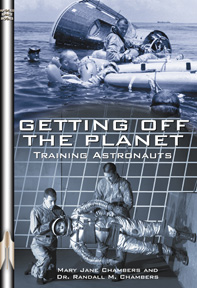 GETTING OFF THE PLANET: Training Astronauts ISBN 9781894959209 $23.95 Canadian
| GETTING OFF THE PLANET: Training Astronauts by Mary Jane Chambers and Dr Randall Chambers Pub Date – Jan / 2006 Getting off the Planet is the story of how a group of dedicated scientists, working with some of the nation's finest pilots, prepared for space flight by meticulous research and patient, relentless testing. The book provides a piece of space history largely missing until now. Introduction by Mary Jane Chambers Anyone who glances at this book may wonder about its authorship. Since Dr. Chambers is a space pioneer and a world-renowned authority on some aspects of space flight training, why is Mrs. Chambers doing most of the writing? This is a good question. The answer can be found in the old saying,“Engineers and scientists tend to tell you more about something than you really want to know!” A case in point is a biologist-friend of ours who spent his entire life studying the chromosome map of the salivary gland of the fruit fly. He was completely unaware that the whole fruit fly—much less his gland—was not of great interest to most of us. Sending a man to the moon, and returning him safely to Earth in July, 1969, was arguably the most significant scientific achievement of the 20th century. It was accomplished by scientists from at least two dozen disciplines—from anatomy to zoology—from laboratories of government, industry and universities. The obstacles to such an undertaking are so enormous that they have seldom been listed anywhere. Most of us rarely—if ever—think about what it would require to get off the planet. We take gravity, which tightly holds everything to Earth, for granted. We rarely take time to appreciate the fact that gravity is so powerful that nobody has ever fallen off the Earth. Or jumped. Astronauts in science fiction seem to glide into the great beyond effortlessly. However, the reality is that physical forces such as gravitational stress, atmospheric pressure, and weightlessness all have to be“conquered” before a safe flight can be made. Beginning in 1958, there were 10 busy years of research—trial, error, testing and rechecking—by scientists of different disciplines to achieve the moon walk. Table of Contents Introduction Chapter 1: From the Beginning Chapter 2: Getting Started Chapter 3: Some Glimpses into Early Space Research Projects Chapter 4: The Biosatellite Pioneers Chapter 5: Astronaut Selection and Training—with Stress, Distress, Zeal and Determination Chapter 6: Acceleration Forces and Stresses: Coping with Gravity Chapter 7: Early Mars Experiments Chapter 8: Microgravity and Weightless Simulations Chapter 9: Atmospheric Pressure Factors Chapter 10: More Glimpses into Early Space Research Projects Chapter 11: All Dressed Up for Space Exploration Chapter 12: So Much for Creature Comforts Chapter 13: Into Space with Mercury, Gemini and Apollo Chapter 14: Exploring the Moon and Returning to Earth Chapter 15: The Shuttle Programs: New Spacecraft, New Missions Chapter 16: Preparing for Sky Lab and Other Space Stations Chapter 17: Meeting the Public Chapter 18: Serendipities Galore! 120 Pages
|